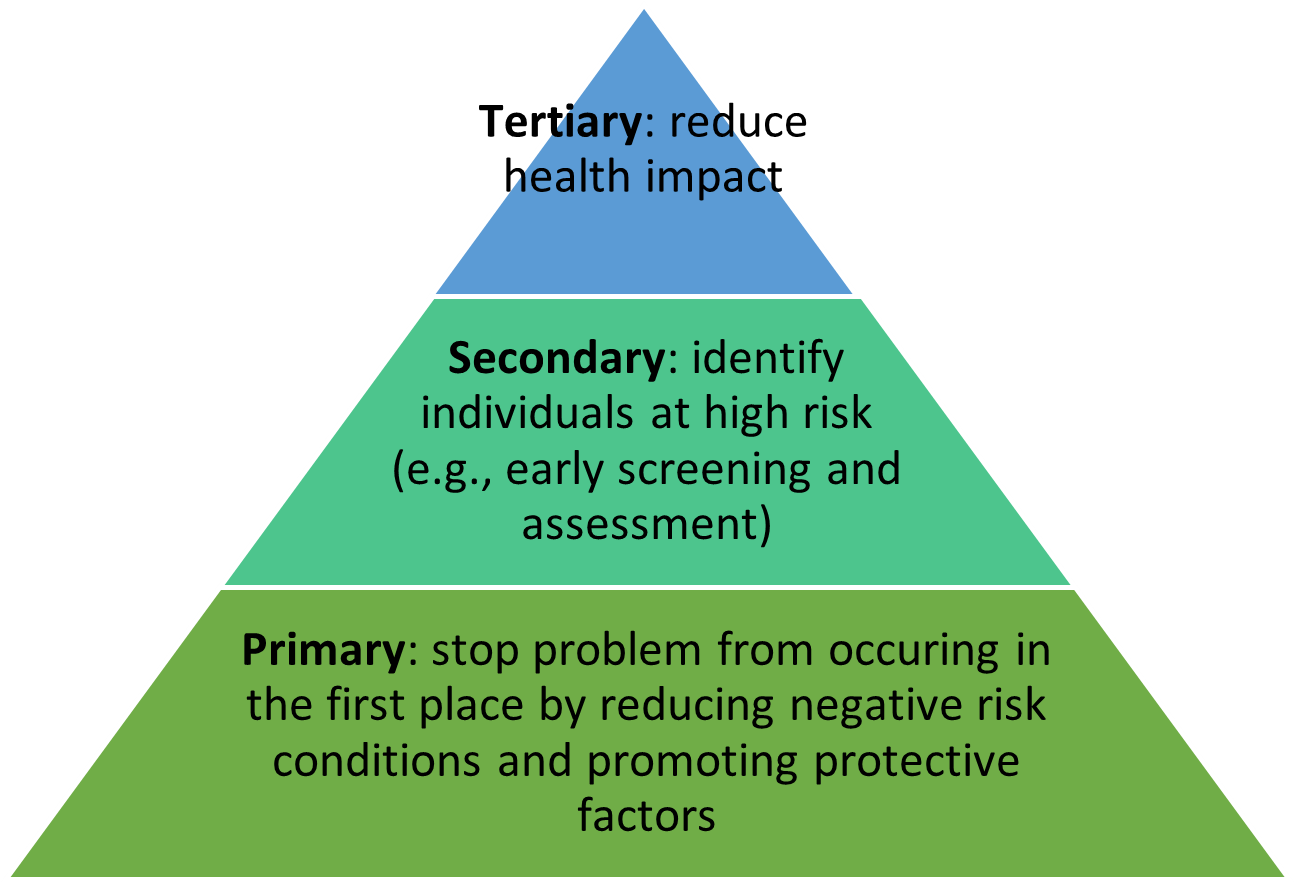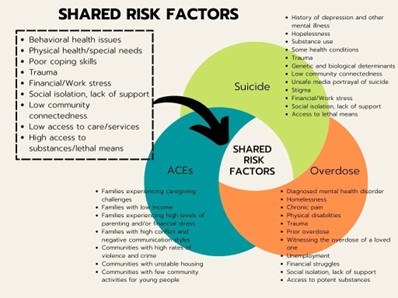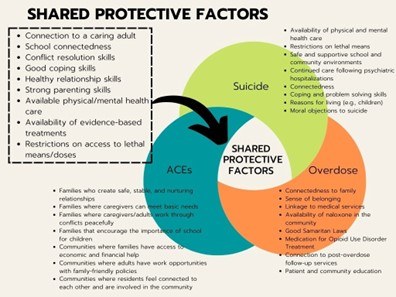Evidence-Based Strategies

Evidence-based prevention strategies are practices, programs, and procedures that have proven effective through research and evaluation. The strategies discussed in the following CDC resources help to direct efforts towards approaches that have demonstrated effectiveness at reducing and preventing the incidence of:
- Suicide: Suicide Prevention Resource for Action
- Overdose: Evidence-Based Strategies for Preventing Opioid Overdose: What’s Working in the United States
- ACEs: Preventing Adverse Childhood Experiences (ACEs): Leveraging the Best Available Evidence
These strategies identify individuals at high risk, intervene to reduce current health impact, and prevent impact on future generations by reducing risk factors and promoting protective factors. Further, the strategies provide a solid foundation through which local health departments (LHDs) can continue to develop and adapt approaches that address the unique needs of their communities.

Look at the results of Q23-28 in your completed SPACECAT to identify opportunities to increase consideration and use of evidence-based strategies.
- Differentiate between evidence-based, emerging, and unsupported prevention strategies. Evidence-based approaches are recommended due to their scientific support and proven effectiveness. Studies have demonstrated that they are effective at achieving outcomes. In comparison, emerging approaches are potentially helpful but less rigorously evaluated innovations that have often been informed by research and/or endorsed by experts in the field but not yet linked to the outcome(s) they claim to achieve. Unsupported approaches have not been informed by research or have not demonstrated any desired impact on outcomes (or have concerning or negative effect).
- Consider which risk and protective factors are for suicide, overdose, and ACEs individually, and which are shared. Shared risk and protective factors that touch these three areas are interconnected, are recognizable and impactful at all levels of the socioecological model and should be the focus of an evidence-based strategy you choose for intersection work. For example, the Communities that Care (CTC) Model involved developing local action plans address youth substance use and violence prevention, with the goal of improving protective factors related to risky behaviors and mental health. Similarly:
- An evidence-based strategy aimed at teaching coping skills, such as Strengthening Families would address the shared risk factor of poor coping skills by providing a protective factor of conflict resolution, coping, relationship, and parenting skills.
- An evidence-based mentoring program could provide the protective factor of connection to a caring adult, a no-cost after-school program could address the risk factor of low community connectedness and financial stress for parents, and so on.
- An evidence-based prevention strategy has the highest likelihood of successful impact when the timing is right. Consider various levels of readiness to determine whether it is the right time to implement a new prevention strategy.
- There are resources available to guide LHDs looking to determine their readiness to approach challenges, implement new programs, or explore new practices. These resources are simply intended as examples; each of them would require changes to assess LHD and community readiness to address shared risk and protective factors:
- If you determine that the agency is ready to move forward, consider similar questions related to the community’s readiness, engaging partners and community members whenever possible.
- Now that you have identified your community’s most important and changeable risk and protective factors and assessed your readiness to implement a new prevention strategy, it is time to find an evidence-based strategy that will be a good conceptual and practical fit for your population of focus, in the current agency and community context.
- Use this checklist to assess whether the strategies you are finding may be a good fit.
- Suicide and ACEs Prevention Multimedia Resources (Prevention Institute)- A resource repository from the Prevention Institute that contains multimedia resources, including briefs, podcasts, and webinars, on suicide and ACEs prevention.
- The Intersection of Opioid Abuse, Overdose, and Suicide: The Role of Chronic Pain (SAMHSA and Suicide Prevention Resource Center)- A webinar focused on the intersections between chronic disease, opioid use, overdose and suicide .
- The Intersection of Opioids and Suicide: Prevention Approach (Substance Abuse and Mental Health Services)- A webinar from the Substance Abuse and Mental Health Services Administration Office of Behavioral Health Equity that provides information and data on the intersection of opioids and suicide.
- Adverse Childhood Experiences and Suicide Prevention Rapid Response Training and Technical Assistance Tools (Prevention Institute)- A resource repository from the Prevention Institute containing numerous training modules, videos, webinars, presentations, and other resources on topics such as suicide prevention, equity prioritization, trauma, and combating these issues during COVID-19.
- The Intersection of Opioid Abuse, Overdose, and Suicide: Understanding the Connections (SAMHSA and Suicide Prevention Resource Center)- A webinar from SAMHSA and SPRC about the intersection of opioid abuse, overdose, and suicide. This webinar is one part of a webinar series.
- Veto Violence: Connecting the Dots (Centers for Disease Control and Prevention)- A webpage from VetoViolence that provides tools including an online training, connections selector, and notes from the field that explore the overlap between multiple forms of violence.
- Suicide & Adverse Childhood Experiences (ACEs): Preventing Suicide through Collaborative Upstream Intervention (Suicide Prevention Resource Center)- A webinar from the Suicide Prevention Resource Center that focuses on the importance of incorporating ACEs in comprehensive suicide prevention efforts.
- Connections Lab: Exploring Elements of Shared Risk & Protective Factor (SRPF) Approaches (Safe States)- A web-based resource from Safe States focused on the holistic risks and protective factors related to substance use, suicide, and other adverse outcomes.
- Applying A Shared Risk and Protective Factor Approach to Injury and Violence Prevention: Evaluating Shared Risk and Protective Factors to Address ACEs, Suicide, and Opioid Misuses- Examples from States- Safe State Alliance Training (Safe States)- A report from Safe States about the protective and risk factors related to Injury and Violence Prevention work, specifically suicide, interpersonal violence and substance use.
- Violence Prevention in Practice: Partnerships (Veto Violence, Centers for Disease Control and Prevention)- Resource guide and toolkit for implementing CDC’s technical packages for violence prevention. This toolkit includes information on creating and sustaining partnerships.
- Suicide Prevention Resource for Action (Centers for Disease Control and Prevention)- A resource that details strategies with the best available evidence to reduce suicide.
- National Strategy for Suicide Prevention: Implementation Assessment Report (Substance Abuse and Mental Health Services Administration)- A report from the Substance Abuse and Mental Health Services Administration that outlines the national strategy for suicide prevention.
- Suicide Prevention Resource Center (SPRC)- A collection of resources from the Suicide Prevention Resource Center that contains resources and programs, training, and state activities for suicide prevention.
- State Suicide Prevention Infrastructure Recommendations (Suicide Prevention Resource Center)- A framework from Suicide Prevention Resource Center that provides guidance and recommendations on state suicide prevention infrastructure.
- Implementing Zero Suicide in Health Care (National Action Alliance for Suicide Prevention)- A resource repository from The Action Alliance that contains an index of resources regarding suicide prevention and health care.
- Zero Suicide Toolkit (ZeroSuicide)- A toolkit from ZeroSuicide that houses various suicide prevention resources, organized across seven elements.
- Resources (ZeroSuicide)- A webpage from Zero Suicide that contains a multitude of resources to help users understand and implement Zero Suicide.
- Building Hope and Resiliency: A Collaborative Approach to Suicide Prevention in Riverside County (Riverside University Health System)- A report from Riverside University Health System that outlines Riverside County's strategic plan for suicide prevention.
- Emergency Room Intervention for Suicidal Adolescent Females (UCLA- Center for HIV Identification, Prevention, Treatment Services)- A program description from El Dorado County that overviews their Emergency Room Intervention program, an evidence-based practice that has shown success during the 3-year study.
- Youth Suicide Prevention Programs by State (Kognito)- A resource repository from Kognito that list youth suicide prevention resources by state.
- Rural Project Examples: Suicide and Suicide Prevention (Rural Health Information Hub)- A resource repository from Rural Health Information that contains examples of suicide and suicide prevention programs in rural communities.
- Rural Suicide Prevention Toolkit (Rural Health Information Hub)- A toolkit from Rural Health Information divided into modules that contains resources focused on the development, implementation, evaluation and sustainment of rural suicide prevention programs. The toolkit also contains evidence-based and promising suicide prevention programs models for rural communities.
- Suicide Prevention (Centers for Disease Control and Prevention)- A resource repository from the Centers for Disease Control and Prevention that contains a host of suicide and suicide prevention resources including CDC's strategic plan, suicide prevention programs, CDC publications and other resources.
- State of State, Territorial, and Tribal Suicide Prevention (Centers for Disease Control and Prevention)- A report developed by the Centers for Disease Control and Prevention detailing the suicide prevention strategies of states, territories, and tribes.
- The Surgeon General's Call to Action to Implement the National Strategy for Suicide Prevention: A Report of the U.S. Surgeon General and of the National Action Alliance for Suicide Prevention (National Action Alliance for Suicide Prevention)- A report developed by the Centers for Disease Control and Prevention detailing the suicide prevention strategies of states, territories, and tribes.
- Preventing Suicide: A Technical Package of Policy, Programs, and Practices (Centers for Disease Control and Prevention)- A report from the Centers for Disease Control and Prevention that contains descriptions of policies, programs, and practices that prevent suicide.
- State Suicide Prevention Planning: A CDC Research Brief (Centers for Disease Control and Prevention)- A report from the Centers for Disease Control and Prevention that presents the findings of a state suicide prevention planning study.
- Injury Prevention Inventory: A Compendium of Injury Prevention Strategies, Sample Measures, & Resources for Suicide (Safe States)- A resource repository from Safe States that outlines several strategies and accompanying resources, sample measures, and other additional resources.
- Evidence-Based Strategies for Preventing Opioid Overdose: What's Working in the United States (Centers for Disease Control and Prevention)- A report from the Centers for Disease Control and Prevention that presents evidence-based strategies for preventing opioid overdose for public health, law enforcement, and community organizations.
- Essential Measures: A Local Public Health Toolkit for Addressing the Opioid Epidemic (Massachusetts Health Officers Association)- A toolkit from the Massachusetts Health Officers Association that has explanations, case examples, and resources for responding to the opioid epidemic through local public health, organized by the ten essential services.
- Local Opioid Prevention and Response: A Primer for Local Health Departments (NACCHO)- A primer that informs local health departments about the domestic opioid epidemic and shares success stories. This document covers five types of activities, including monitoring and surveillance, prevention, harm reduction, linkages to care, stakeholder engagement, and community partnerships.
- Post-Overdose Response Team Toolkit (North Carolina Department of Health and Human Services)- A toolkit from the North Carolina Department of Health and Human Services that helps communities assess the need for a post-overdose response team, design and implement the program, and evaluate the program to make improvements.
- Implementing Medication-Assisted Treatment for Opioid Use Disorder: A Planning and Implementation Toolkit (National Council for Mental Wellbeing)- A toolkit from the National Council for Behavioral Health that contains information to advance the implementation of evidence-based medications for opioid use disorder within jail and prison settings..
- Medication-Assisted Treatment for Opioid Use Disorder Playbook (Agency for Healthcare Research and Quality)- A practical guide from The AHRQ Academy that provides information for primary care providers implementing medication-assisted treatment, particularly in rural settings.
- Resources for Health Professionals, Patients and Community (Providers Clinical Support System)- A collection of resources from the Providers Clinical Support System that treat opioid use disorder and chronic pain for health professionals, patients, family members, and the community.
- Law Enforcement Naloxone Toolkit (Bureau of Justice Assistance)- A tool from the Bureau of Justice Assistance that identifies resources such as trainings, educational materials, policies/procedures, and reports that may help strengthen law enforcement’s capacity to prevent and respond to the overdose epidemic.
- Syringe Services Programs: A Technical Package of Effective Strategies and Approaches for Planning, Design and Implementation (Centers for Disease Control and Prevention)- A technical package from the Centers for Disease Control and Prevention that provides a broad framework for new and existing syringe service programs to ensure needs-based service delivery, reduce harms related to injection drug use, and link participants to services that support their health and wellness.
- Guide to Establishing Syringe Services Programs in Rural, At-Risk Areas (Comer Family Foundation)- A comprehensive guide from the Comer Family Foundation with harm reduction resources and specific examples from communities in Kentucky, West Virginia, Indiana, and North Carolina.
- A Rapid-Cycle Assessment Strategy for Understanding the Opioid Epidemic in Local Communities (Allegheny County Health Department)- A report from the Allegheny County Health Department that describes the rapid-cycle assessment approach used with their Community Opioid Project.
- Overdose Prevention (Centers for Disease Control and Prevention)- A resource repository from the Centers for Disease Control and Prevention that contains information on opioid prescribing, treatment for opioid use disorder, overdose reversal, and evidence-based strategies for prevention.
- Conducting Affordable Care Act, Community Health Needs Assessments (CHNA) Targeted at the Opioid Overdose Epidemic (NACCHO and George Mason University)- A practicum project developed with NACCHO that provides guidance on how the CHNA process can address substance misuse.
- Opioid Epidemic Toolkit 2021 (NACCHO)- A toolkit from NACCHO that contains a multitude of resources, organized by topic and level, that support local health departments in their overdose prevention efforts.
- Build State, Local, and Tribal Capacity to Respond to Opioid Overdoses (Centers for Disease Control and Prevention)- A resource repository from the Centers for Disease Control and Prevention that provides information on programs working to build capacity in state, local communities, and tribes to prevent opioid overdoses.
- Opioid Overdose Prevention Toolkit(Substance Abuse and Mental Health Services Administration)- A toolkit from the Substance Abuse and Mental Health Services Administration that includes education on opioid use disorder, essential steps for first responders, information for prescribers, safety advice for patients and their families, and recovery strategies after experiencing an overdose.
- Useful Resources on Opioid Overdose Prevention in Homeless Population (Substance Abuse and Mental Health Services Administration)- A collection of resources from the Substance Abuse and Mental Health Services Administration for overdose prevention specifically in relation to people experiencing homelessness.
- Overdose Prevention and Response (King County)- A local initiative from King County that contains data dashboards, evaluations and reports, policy and opioid response plans, and other services and resources involving overdose prevention and response.
- Harm Reduction Resource Center (National Harm Reduction Coalition)- A collection of resources from the National Harm Reduction Coalition categorized by issue and type, including brochures, fact sheets, webinars, training guides, and podcasts.
- Templates for Local Health Department Opioid Prevention & Response: A How To Guide (NACCHO)- A reference document from NACCHO that supports local health departments as they plan for, implement, and evaluate their efforts using NACCHO’s Action Plan, Budget Plan, and Evaluation Plan Templates.
- The Opioid Use Disorder Prevention Playbook (National Interoperability Collaborative)- A “playbook” from the National Interoperability Collaborative highlighting strategies that communities can replicate or adapt in real time to prevent opioid use disorder.
- Rural Opioid Educational Resources (National Organization of State Officers of Rural Health)- A comprehensive repository of resources from the National Organization of State Offices of Rural Health for opioid response in rural communities, including customizable resources, training materials, and reports.
- Selecting Best-fit Programs and Practices: Guidance for Substance Misuse Prevention Practitioners (Substance Abuse and Mental Health Service Administration)- Toolkit from SAMHSA with guidance for how to develop evidence-based programs and practices to prevent overdose and substance misuse.
- A Sustainability Planning Guide for Healthy Communities (Centers for Disease Control and Prevention)- A framework from the Centers for Disease Control and Prevention that outlines sustainability policy strategies and science-and-practice-based evidence in order to aid agencies in the development, implementation, and evaluation of their own sustainability plans.
- Program Sustainability Assessment Tool (Centers for Public Health Systems Science)- A tool from the Centers for Public Health Systems Science that helps agencies rate the sustainability capacity of their programs.
- Preventing Adverse Childhood Experiences: Leveraging the Best Available Evidence (Centers for Disease Control and Prevention)- A report from the Centers for Disease Control and Prevention that contains information on evidence-based ACE prevention practices.
- Trauma-Informed Toolkit for Health Care Providers (Health & Medicine Policy Research Group)- A toolkit from the Health & Medicine Policy Research Group and the Illinois ACEs Response Collaborative that includes assessment tools, samples presentations, staff wellness resources, videos on trauma-informed, and ACEs 101 resources.
- Child Abuse and Neglect (Centers for Disease Control and Prevention)- A resource repository from VetoViolence on child abuse and neglect prevention, including general information, CDC-developed resources, and data on the subject.
- ACEs Aware (ACEs Aware)- A resource repository from ACEs Aware that contains information, trainings, and resources on the fundamentals of ACEs, including the science of ACEs and toxic stress, trauma-informed care, ACEs screening, and treatment.
- Preventing Child Abuse and Neglect: A Technical Package for Policy, Norm, and Programmatic Activities (Centers for Disease Control and Prevention)- A technical package from the Centers for Disease Control and Prevention that provides evidence-based strategies to prevent child abuse and neglect.
- Adverse Childhood Experiences (ACEs) (Centers for Disease Control and Prevention)- A resource repository from the Centers for Disease Control and Prevention that includes information about prevention strategies, ACEs for youth at risk, ACE data, and funded research.
- A Review of Community Efforts to Mitigate and Prevent Adverse Childhood Experiences and Trauma (Washington State University)- A report from Washington State University that discuss how to create a public health model for ACEs prevention and mitigations, the evidence base for community prevention efforts, and community programs defining ACEs-related collaborative efforts.
- Integrating ACE-Informed Practice into the Blueprint for Health (Department of Vermont Health Access)- A literature review from the Department of Vermont Health Access detailing evidence-based practices and interventions that reduce and treat ACEs.
- Preventing and Mitigating the Effects of Adverse Childhood Experiences (National Conference of State Legislatures)- A report from the National Conference of State Legislatures that describes evidence-based state ACE prevention strategies.
- Additional Resources for Creating Safe, Stable, and Nurturing Relationships and Environments (Kansas Department of Health and Environment)- A resource repository from the Kansas Department of Health and Environment that contains links to several resources including Baby Buffer, the Building Community Resilience Collaborative, and The Resilience Project.
- Child Abuse Prevention and Child Welfare: Collaborating for Creative Solutions (FRIENDS National Resource Center for Community-Based Child Abuse Prevention)- A framework from FRIENDS National Resource Center for Community-Based Child Abuse Prevention that provides guidance on developing collaborations.
- Collaboration Toolkit (FRIENDS National Resource Center for Community-Based Child Abuse Prevention)- A toolkit from FRIENDS National Resource Center for Community-Based Child Abuse Prevention that provides tools and resources, categorized across ten elements.
- Neglect Toolkit (FRIENDS National Resource Center for Community-Based Child Abuse Prevention)- A toolkit from FRIENDS National Resource Center for Community-Based Child Abuse Prevention that serves to assist state agencies and other partners in their comprehension of neglect. The toolkit also contains strategies, specific examples, and other resources about child neglect.
- Kitsap Strong Impact Report (Kitsap Community Foundation)- A report from Kitsap Community Foundation that highlights their work to increase health and safety outcomes for children and families.
- Evidence-Based Programs/Data (Local)- A resource repository from PACES Connection that includes evidence-based ACE prevention programs and ACE measures.
- Adverse Childhood Experiences: Madison County Department of Public Health (Madison County Department of Health)- A report from Madison County Department of Health that includes current local ACE prevention initiatives and prevention recommendations organized by tier.
- Essentials for Childhood Resources (California Department of Health)- A resource repository from the California Department of Health that includes: an e-guide, data reports, fact sheets, and frameworks, among other resources.
- Adverse Childhood Experiences and Resilience: Understanding, Addressing, and Preventing Community Trauma (Prevention Institute)- A resource repository from the Prevention Institute that contains publications, local initiatives, frameworks, and media covering ACEs and community trauma.
- A Review of Community Efforts to Mitigate and Prevent Adverse Childhood Experiences and Trauma (Washington State University)- A report that discusses how to create a public health model for ACEs prevention and mitigations, the evidence base for community prevention efforts, and community programs defining ACEs-related collaborative efforts. A portion of the report contains information on utilizing partnerships to help promote ACEs-related programming.
This page is part of the SPACECAT Toolkit. It was last updated on September, 2022. To report broken links, please email [email protected].

